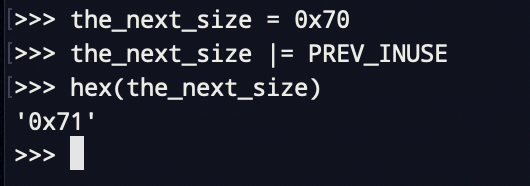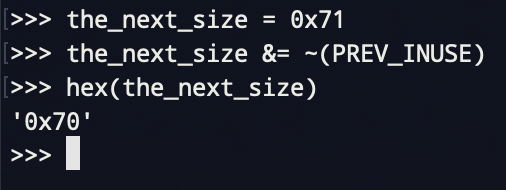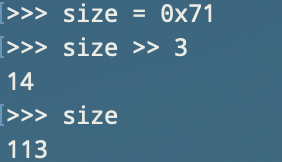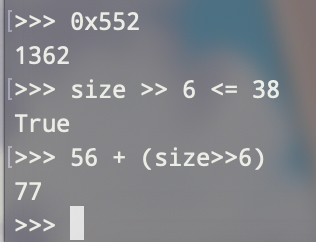读书摘要观后感与总结:《Glibc内存管理:ptmalloc2源代码分析》
更新中
在Linux平台下做漏洞利用的时候,针对于Heap部分总是有些不求甚解,下面开个博文来记录下《Glibc内存管理:ptmalloc2源代码分析》这本书的读后感和收获,一些简单的点将不再记录
说明,本博文中所有的实验均在Linux Ubuntu16.04的环境下进行
目录树:
一些关于计算size的宏
"chunk to mem" and "mem to chunk"
about size
分箱式内存管理
smallbins
largebins
一些关于计算size的宏
Ptmalloc设计的时候很巧妙的一点就是利用宏来屏蔽不同平台的差异,一些简单的细节比如chunk的形式在此我就不再赘述,下面记录一下读后有收获的点
"chunk to mem" and "mem to chunk"
/* conversion from malloc headers to user pointers, and back */
#define chunk2mem(p) ((void*)((char*)(p) + 2*SIZE_SZ))
#define mem2chunk(mem) ((mchunkptr)((char*)(mem) - 2*SIZE_SZ))
about size
MIN_CHUNK_SIZE定义了最小的chunk大小,MINSIZE定义了最小的分配的内存大小,是对MIN_CHUNK_SIZE进行了2*SIZE_SZ对齐,对齐后与MIN_CHUNK_SIZE的大小仍然是一样的
/* The smallest possible chunk */
#define MIN_CHUNK_SIZE (offsetof(struct malloc_chunk, fd_nextsize))
/* The smallest size we can malloc is an aligned minimal chunk */
#define MINSIZE \
(unsigned long)(((MIN_CHUNK_SIZE+MALLOC_ALIGN_MASK) & ~MALLOC_ALIGN_MASK))
下面说明一下chunk是如何计算其size的
/* size field is or'ed with PREV_INUSE when previous adjacent chunk in use */
#define PREV_INUSE 0x1
/* extract inuse bit of previous chunk */
#define prev_inuse(p) ((p)->mchunk_size & PREV_INUSE)
/* size field is or'ed with IS_MMAPPED if the chunk was obtained with mmap() */
#define IS_MMAPPED 0x2
/* check for mmap()'ed chunk */
#define chunk_is_mmapped(p) ((p)->mchunk_size & IS_MMAPPED)
/* size field is or'ed with NON_MAIN_ARENA if the chunk was obtained
from a non-main arena. This is only set immediately before handing
the chunk to the user, if necessary. */
#define NON_MAIN_ARENA 0x4
#define SIZE_BITS (PREV_INUSE | IS_MMAPPED | NON_MAIN_ARENA)
/* Like chunksize, but do not mask SIZE_BITS. */
#define chunksize_nomask(p) ((p)->mchunk_size)
/* Get size, ignoring use bits */
#define chunksize(p) (chunksize_nomask (p) & ~(SIZE_BITS))
/* Ptr to next physical malloc_chunk. */
#define next_chunk(p) ((mchunkptr) (((char *) (p)) + chunksize (p)))
/* Size of the chunk below P. Only valid if !prev_inuse (P). */
#define prev_size(p) ((p)->mchunk_prev_size)
比如做个实验来验证下,我们的chunksize为0x71,那么它本身的真实size是如何计算的?
根据宏定义来计算
可以看到计算得出的结果显然正确

下面这一组宏定义用来check/set/clear当前chunk使用标志位,有当前chunk的使用标志位存储在下一个chunk的size的P位,所以下面的宏都要首先算出来下一个chunk的地址
然后再做处理
/* extract p's inuse bit */
#define inuse(p) \
((((mchunkptr) (((char *) (p)) + chunksize (p)))->mchunk_size) & PREV_INUSE)
/* set/clear chunk as being inuse without otherwise disturbing */
#define set_inuse(p) \
((mchunkptr) (((char *) (p)) + chunksize (p)))->mchunk_size |= PREV_INUSE
#define clear_inuse(p) \
((mchunkptr) (((char *) (p)) + chunksize (p)))->mchunk_size &= ~(PREV_INUSE)
我们可以简单来实验一下
define inuse(p) 定义p的inuse

define set_inuse(p) 设置p的inuse位(p的nextchuhnk来设置)

define clear_inuse(p) 清理p的inuse位

下面三个宏用来check/set/clear指定chunk的size域中的使用标志位
/* check/set/clear inuse bits in known places */
#define inuse_bit_at_offset(p, s) \
(((mchunkptr) (((char *) (p)) + (s)))->mchunk_size & PREV_INUSE)
#define set_inuse_bit_at_offset(p, s) \
(((mchunkptr) (((char *) (p)) + (s)))->mchunk_size |= PREV_INUSE)
#define clear_inuse_bit_at_offset(p, s) \
(((mchunkptr) (((char *) (p)) + (s)))->mchunk_size &= ~(PREV_INUSE))
分箱式内存管理
smallbins
smallbins有64个bin,实际共62个bin,bin[0]和bin[1]不存在
chunk_size = 2 * SIZE_SZ * index
范围:16B-504B (32B-1008B)
ptmalloc维护了62个双向环形链表,每个链表都有头节点,便于管理,每个链表内各个空闲的chunk的大小一致
largebins
32:大于等于512B
64:大于等于1024B
一共63个bins
每个bin中的chunk大小不是一个固定公差的等差数列,而是分成6组bin,每组bin是一个固定公差的等差数列
每组的bin数量依次为:32,16, 8, 4, 2, 1
公差依次为: 64,512,4096,32768,262144
可以用数学来描述计算largebins的chunk_size
第一组:chunksize = 512 + 64 * index
第二组:chunksize = 512 + 64 * 32 + 512 * index
……
可以看到,其实smallbins和largebins差不多满足同样的规律,所以可以将small bins和large bins放在同一个包含128个chunk的数组上,数组前一部分为small bins,后一部分为large bins。
每个bin的index是chunk数组的下标,于是,可以根据下标来计算chunk大小(small bins)或者chunk大小范围(large bins)
同样也可以计算所需chunk所属bin的index,ptmalloc使用一组宏来完成计算
宏bin_index(sz)根据所需内存大小来计算出所需bin的index(如果是用户要分配的size,先使用checked_request2size来计算出chunk的大小)
/*
Indexing
Bins for sizes < 512 bytes contain chunks of all the same size, spaced
8 bytes apart. Larger bins are approximately logarithmically spaced:
64 bins of size 8
32 bins of size 64
16 bins of size 512
8 bins of size 4096
4 bins of size 32768
2 bins of size 262144
1 bin of size what's left
There is actually a little bit of slop in the numbers in bin_index
for the sake of speed. This makes no difference elsewhere.
The bins top out around 1MB because we expect to service large
requests via mmap.
Bin 0 does not exist. Bin 1 is the unordered list; if that would be
a valid chunk size the small bins are bumped up one.
*/
#define NBINS 128
#define NSMALLBINS 64
#define SMALLBIN_WIDTH MALLOC_ALIGNMENT
#define SMALLBIN_CORRECTION (MALLOC_ALIGNMENT > 2 * SIZE_SZ)
#define MIN_LARGE_SIZE ((NSMALLBINS - SMALLBIN_CORRECTION) * SMALLBIN_WIDTH)
#define in_smallbin_range(sz) \
((unsigned long) (sz) < (unsigned long) MIN_LARGE_SIZE)
#define smallbin_index(sz) \
((SMALLBIN_WIDTH == 16 ? (((unsigned) (sz)) >> 4) : (((unsigned) (sz)) >> 3))\
+ SMALLBIN_CORRECTION)
#define largebin_index_32(sz) \
(((((unsigned long) (sz)) >> 6) <= 38) ? 56 + (((unsigned long) (sz)) >> 6) :\
((((unsigned long) (sz)) >> 9) <= 20) ? 91 + (((unsigned long) (sz)) >> 9) :\
((((unsigned long) (sz)) >> 12) <= 10) ? 110 + (((unsigned long) (sz)) >> 12) :\
((((unsigned long) (sz)) >> 15) <= 4) ? 119 + (((unsigned long) (sz)) >> 15) :\
((((unsigned long) (sz)) >> 18) <= 2) ? 124 + (((unsigned long) (sz)) >> 18) :\
126)
#define largebin_index_32_big(sz) \
(((((unsigned long) (sz)) >> 6) <= 45) ? 49 + (((unsigned long) (sz)) >> 6) :\
((((unsigned long) (sz)) >> 9) <= 20) ? 91 + (((unsigned long) (sz)) >> 9) :\
((((unsigned long) (sz)) >> 12) <= 10) ? 110 + (((unsigned long) (sz)) >> 12) :\
((((unsigned long) (sz)) >> 15) <= 4) ? 119 + (((unsigned long) (sz)) >> 15) :\
((((unsigned long) (sz)) >> 18) <= 2) ? 124 + (((unsigned long) (sz)) >> 18) :\
126)
// XXX It remains to be seen whether it is good to keep the widths of
// XXX the buckets the same or whether it should be scaled by a factor
// XXX of two as well.
#define largebin_index_64(sz) \
(((((unsigned long) (sz)) >> 6) <= 48) ? 48 + (((unsigned long) (sz)) >> 6) :\
((((unsigned long) (sz)) >> 9) <= 20) ? 91 + (((unsigned long) (sz)) >> 9) :\
((((unsigned long) (sz)) >> 12) <= 10) ? 110 + (((unsigned long) (sz)) >> 12) :\
((((unsigned long) (sz)) >> 15) <= 4) ? 119 + (((unsigned long) (sz)) >> 15) :\
((((unsigned long) (sz)) >> 18) <= 2) ? 124 + (((unsigned long) (sz)) >> 18) :\
126)
#define largebin_index(sz) \
(SIZE_SZ == 8 ? largebin_index_64 (sz) \
: MALLOC_ALIGNMENT == 16 ? largebin_index_32_big (sz) \
: largebin_index_32 (sz))
#define bin_index(sz) \
((in_smallbin_range (sz)) ? smallbin_index (sz) : largebin_index (sz))
对于x86,bin[0]和bin[1]不存在,而NBINS定义为128,其实bin[0]和bin[127]都不存在,bin[1]为unsorted bin的chunk链表头
通过查表可验证以上算法的正确性


宏bin_at通过bin_index来获得bin的链表头,next_bin用于获得下一个bin的地址,first用于获得bin的第一个可用chunk,last用于获得最后一个可用chunk
/* addressing -- note that bin_at(0) does not exist */
#define bin_at(m, i) \
(mbinptr) (((char *) &((m)->bins[((i) - 1) * 2])) \
- offsetof (struct malloc_chunk, fd))
/* analog of ++bin */
#define next_bin(b) ((mbinptr) ((char *) (b) + (sizeof (mchunkptr) << 1)))
/* Reminders about list directionality within bins */
#define first(b) ((b)->fd)
#define last(b) ((b)->bk)
读书摘要观后感与总结:《Glibc内存管理:ptmalloc2源代码分析》的更多相关文章
- 《Glibc内存管理》笔记DAY5
目录 分箱式内存管理 Unsorted bin Fast bins 核心结构体分析 malloc_state 内容来源 分箱式内存管理 Unsorted bin Unsorted bin 可以看作 ...
- 《Glibc内存管理》笔记DAY4
目录 分箱式内存管理 Small bins Large bins 内容来源 分箱式内存管理 对于空闲的 chunk,ptmalloc 采用分箱式内存管理方式,根据空闲 chunk 的大小和处于的状 ...
- 《Glibc内存管理》笔记DAY3
目录 边界标记法 内容来源 边界标记法 /* conversion from malloc headers to user pointers, and back */ #define chunk2me ...
- 《Glibc内存管理》笔记DAY2
目录 Ptmalloc内存管理设计 Main_arena 与 non_main_arena chunk 的组织 空闲 chunk 容器 sbrk 与 mmap 内存分配概述 内存回收概述 边界标记法 ...
- 《Glibc内存管理》笔记DAY1
目录 x86_64栈和mmap固定映射地址 内存的延迟分配 内核数据结构 mm_struct Heap 操作相关函数 Mmap 映射区域操作相关函数 内容来源 x86_64栈和mmap固定映射地址 ...
- glibc内存管理那些事儿
本文转载自glibc内存管理那些事儿 Linux内存空间简介 32位Linux平台下进程虚拟地址空间分布如下图: 进程虚拟地址空间分布 图中,0xC0000000开始的最高1G空间是内核地址空间,剩下 ...
- 2万字|30张图带你领略glibc内存管理精髓(因为OOM导致了上千万损失)
前言 大家好,我是雨乐. 5年前,在上家公司的时候,因为进程OOM造成了上千万的损失,当时用了一个月的时间来分析glibc源码,最终将问题彻底解决. 最近在逛知乎的时候,发现不少人有对malloc/f ...
- Linux-0.11内核源代码分析系列:内存管理get_free_page()函数分析
Linux-0.11内存管理模块是源码中比較难以理解的部分,如今把笔者个人的理解发表 先发Linux-0.11内核内存管理get_free_page()函数分析 有时间再写其它函数或者文件的:) /* ...
- objective-C 的内存管理之-实例分析
objective-C 的内存管理之-实例分析 注:这是<Objective-C基础教程>一书上的实例,但是原书限于篇幅,分析得比较简单,初次阅读看得比较费劲,这里展开详细讨论一下. 场景 ...
随机推荐
- git修改未push和已经push的注释信息
修改还未push的注释: git commit --amend 修改后保存退出. 刚刚push到远端还没有人其他人下载或改动的: git commit --amend1进入修改页面修改注释信息,修改后 ...
- linux内存分配与回收
前言 之前在实习时,听了 OOM 的分享之后,就对 Linux 内核内存管理充满兴趣,但是这块知识非常庞大,没有一定积累,不敢写下,担心误人子弟,所以经过一个一段时间的积累,对内核内存有一定了解之后, ...
- pwnable.kr-shellshock-witeup
思路是:发现文件执行没什么好反馈显示结果的,于是看文件和权限,通过bash文件猜测可能存在破壳漏洞(CVE-2014-6271)漏洞,于是利用它并结合文件权限成功获得flag. 通过scp下载文件至本 ...
- 报错: Failed to establish a new connection: [WinError 10061] 由于目标计算机积极拒绝,无法连接。'))
你没打开 1.双击打开 2.点击:
- burp suite之Target(目标)
Target : 将攻击的目标,全部展现到Target下. Site map:站点地图 Scope: 范围 目录爬行: 复制所有子目录的链接 Spidor this host: 发送至Spidor选项 ...
- 基础篇:JAVA资源之IO、字符编码、URL和Spring.Resource
目录 1 JAVA.IO字节流 2 JAVA.IO字符流 3 乱码问题和字符流 4 字符集和字符编码的概念区分 5 URI概念的简单介绍 6 URL概念及与URL的区别 7 Spring.Resour ...
- python中numpy.savetxt 参数
转载:https://blog.csdn.net/qq_36535820/article/details/99543188 numpy.savetxt 参数 numpy.savetxt(fname,X ...
- 一键安装PyCharm
1.准备阶段,首先去官网下载:https://download.jetbrains.8686c.com/python/pycharm-professional-2019.1.exe 官网地址:http ...
- 搭建单机版的kafka
搭建单机版的kafka
- vue 异步提交php 两种方式传值
1.首先要在php的入口文件写上一条代码,允许异步提交 header("ACCESS-CONTROL-ALLOW-ORIGIN:*"); 2.在vue有两种方式将数据异步提交到ph ...
